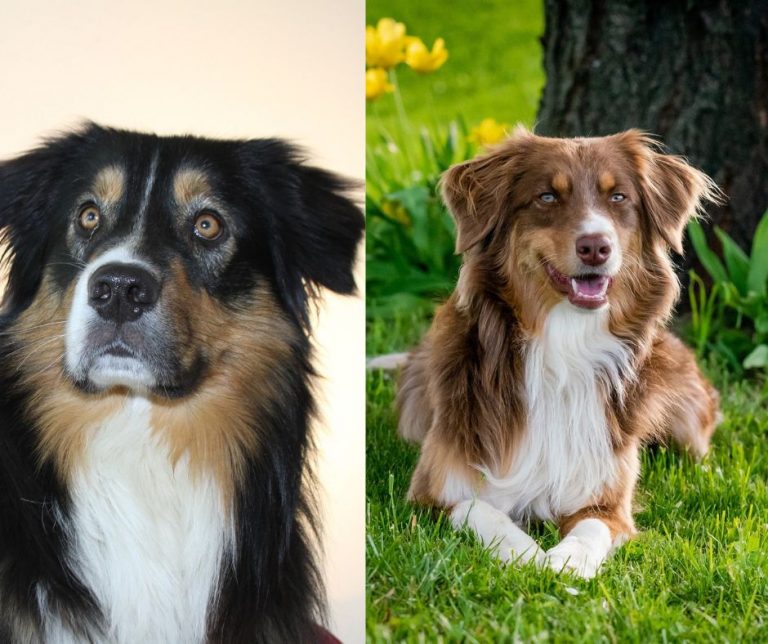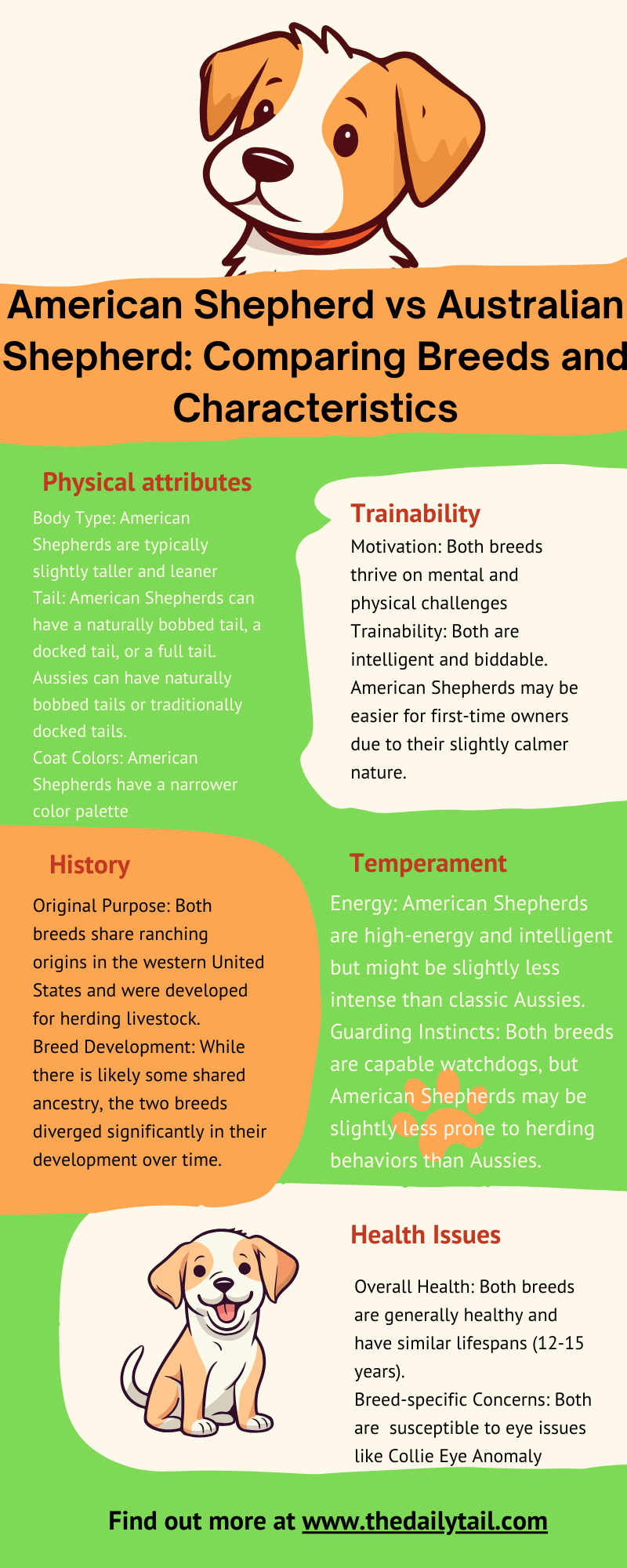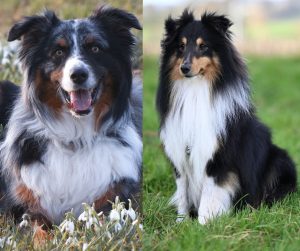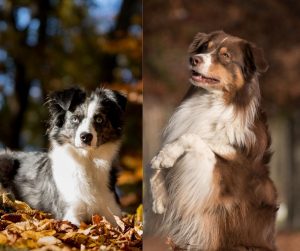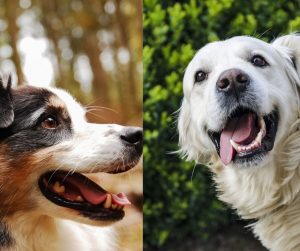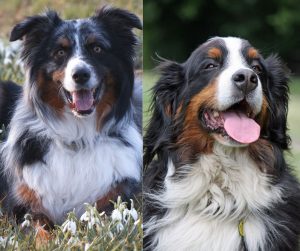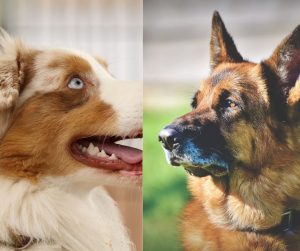The American Shepherd, also known as the Miniature American Shepherd, is a breed that traces its roots to the Australian Shepherd. Despite their shared lineage, these two breeds exhibit distinct characteristics that cater to different preferences and lifestyles. The American Shepherd, recognized officially by the United Kennel Club in 2019, is typically smaller than the Australian Shepherd, with a more muscular build that reflects its adaptation to various environments and work demands.
On the other hand, the Standard Australian Shepherd is revered for its versatility as a working dog and is well-known for its intelligence and energy. Though originally bred in the United States to herd livestock, the breed has gained international popularity for its obedience and agility. The Australian Shepherd’s larger size and high energy make it suitable for active families or individuals with ample space.
Both breeds possess herding instincts and are highly trainable, making them excellent companions for households and work settings alike. Their differences, primarily in size and exercise needs, are significant factors to consider when choosing the right dog to fit one’s lifestyle. With proper care and training, American and Australian Shepherds can both make loyal and affectionate additions to a home.
Having lived with dogs my whole life, I believe picking the right breed goes beyond appearances. Let’s unravel the American Shepherd vs Australian Shepherd distinction
Origin and History
The Australian Shepherd and the American Shepherd, commonly known as “Aussies,” are distinct dog breeds with unique histories. Despite their names, both breeds share an American heritage, with intricate developments leading to their recognition. The American Kennel Club has recognized only the Australian Shepherd, both as Mini Aussie and Standard Aussie. The AKC sets the breed standard for the dog breed.
Ancestry and Development
Australian Shepherd: Contrary to its name, the Aussie Shepherd did not originate in Australia but in the United States, with roots traced back to the Basque region of Spain. The Basque shepherds, along with their dogs, immigrated to the vast ranches of California, where the breed was refined and perfected for herding.
American Shepherd: The American Shepherd, formally known as the Miniature Australian Shepherd, is a smaller version of the Australian Shepherd with a similar working dog lineage. This breed came into existence as a response to the demand for a more compact herding dog suitable for smaller spaces.
Breed Recognition
- Australian Shepherd:
- Recognized by the American Kennel Club (AKC) as part of the herding group
- Developed for rigorous farm and ranch work
- American Shepherd:
- Recognized by the United Kennel Club (UKC) in 2019
- Established a separate breed status from the Australian Shepherd
Both breeds demonstrate high intelligence, strong work ethic, and are highly valued for their herding capabilities.
Physical Characteristics
In the comparison between the American Shepherd vs Australian Shepherd, discernible differences are evident in their size, coat, and distinctive physical traits.
Size Comparison
The American Shepherd and Australian Shepherd differ notably in size.
- American Shepherd
- Height: 13-18 inches
- Weight: 20-40 pounds
- Australian Shepherd
- Height: Up to 23 inches
- Weight: 40-65 pounds
The American Shepherd is generally smaller than its Australian counterpart.
Coat and Color Variations
Coat type and color variations are distinctive characteristics between these two breeds.
- Coat Type:
- The American Shepherd typically has a shorter coat
- The Australian Shepherd’s coat is of medium length and may require more grooming
- Color Patterns:
- American Shepherd: Commonly seen in black, white, tan, blue merle, and red merle
- Australian Shepherd: Also found in black, white, tan, blue merle, and red merle
These breeds both have a rich variety of coat colors, including merle patterns.
Distinctive Traits
Each dog breed possesses unique physical traits that are easy to spot.
- Ears:
- American Shepherd: The ears are small and triangular, often set high on the head
- Australian Shepherd: Australian Shepherds also have triangular ears, which may break forward
- Tail:
- The American Shepherd may have a naturally bobbed tail
- The Australian Shepherd commonly has a full, longer tail, although it can be docked
- Eyes:
- Both may exhibit a variety of eye colors, sometimes even having two different colors within the same pair
The breeds’ ears, tails, and eyes contribute significantly to their recognizable appearances.
American Shepherd vs Australian Shepherd Temperament
Both American and Australian Shepherds display energetic and affectionate temperaments, marked by a blend of loyalty and intelligence. They thrive in active environments and show distinct social traits.
Behavioral Patterns
American Shepherd
- Energetic and Intelligent: They often exhibit high levels of energy and require ample mental and physical stimulation
- Protective: This breed may show a protective nature towards their family, sometimes displaying wariness around strangers
Australian Shepherd
- Loyal and Happy: Known for their strong loyalty, they are typically joyous dogs that bond deeply with their owners
- Sensitivity: Australian Shepherds have a sensitive side and can react to their owner’s emotions, making them well-attuned to family dynamics
Social Traits
American Shepherd
- Friendly and Social: While they can be protective, they are usually friendly once comfortable, enjoying the company of their human family and other pets
- Adaptability: Their adaptability to different social situations can make them suitable for various household environments
Australian Shepherd
- Affectionate and Social: Australian Shepherds tend to be very affectionate with their families and are generally friendly with both people and other dogs
- Interaction with Other Animals: They may have a strong herding instinct, which can influence their interactions with other animals
Health and Lifespan
When considering the American Shepherd and Australian Shepherd, it is vital to understand their breed-specific health issues and expected lifespan. This awareness can help in providing the best care for these herding breeds.
Common Health Issues
Both breeds are prone to some genetic health concerns worth noting. Here’s a brief overview:
- Hip Dysplasia: A deformation that can cause pain and arthritis
- Elbow Dysplasia: Similar to hip dysplasia, affecting the elbows
- Dental Issues: Regular dental check-ups are essential
- Epilepsy: A neurological disorder that can be managed with proper care
- Cataracts: A common eye condition that can lead to blindness if untreated
- Degenerative Myelopathy: A spinal cord disorder leading to paralysis
- Progressive Retinal Atrophy: An eye disease causing progressive blindness
Lifespan Expectancy
Regarding life expectancy, Australian Shepherds have a lifespan typically ranging from 12 to 15 years, while Miniature American Shepherds often enjoy a similar lifespan. Proactive healthcare and regular veterinary check-ups can contribute positively to their longevity.
Exercise and Mental Stimulation
American and Australian Shepherds, both stemming from a herding lineage, possess high energy levels requiring ample exercise and mental stimulation to maintain their well-being.
Activity Requirements
American Shepherds are active canines that thrive on daily exercise. They require at least 1 hour of physical activity per day to satisfy their exercise needs. This may include activities such as:
- Agility training: They excel in navigating obstacle courses, demonstrating their swift reflexes
- Running: A consistent running routine is vital for their physical health
- Fetch: Engaging them in a game of fetch not only exhausts their energy but also provides mental stimulation
Australian Shepherds also demand a significant amount of physical activity. These dogs are known for their:
- Endurance: They can participate in extended periods of exercise without tiring easily
- Versatility in activities: Besides traditional exercises, they enjoy varied workouts including hiking or advanced dog sports
Training and Obedience
Trainability is a strong suit in both breeds. These intelligent dogs respond well to:
- Positive reinforcement: Reward-based training methods yield excellent results
- Consistency: Regular, consistent training sessions are crucial for obedience
American Shepherds are known for being:
- Watchful: They are eager to learn and please their owners, making training a rewarding experience
- Family-friendly: Their trainability makes them a suitable match for households with children
Australian Shepherds’ trainability includes:
- Mental exercises: These are as important as physical exercises. Skills like problem-solving can be enhanced through interactive games and advanced training
- Obedience exercises: They help in managing the breed’s herding instincts positively
In both breeds, a perfect combination of physical activities and obedience training ensures a well-rounded regimen, catering to their mental and physical needs.
Care and Maintenance
When considering the American Shepherd compared to the Australian Shepherd, one must pay careful attention to their distinct care and maintenance requirements. Both breeds demand a consistent routine that includes grooming and a well-balanced diet to ensure their health and well-being.
Grooming Needs
American Shepherd
- Shedding: Moderate to High; more during seasonal changes
- Routine: Weekly brushing, more frequently during shedding seasons
Australian Shepherd
- Shedding: High; sheds year-round with heavier shedding during spring and fall
- Routine: Brushing 2-3 times per week to prevent tangles and mats
Both breeds require regular nail trimming, ear cleaning, and dental care as part of their grooming needs. They can be prone to matting, especially behind the ears and under the elbows, thus owners must be diligent in their grooming practices.
Diet and Nutrition
American Shepherd
- Dietary Needs: High-quality dog food appropriate for their age, size, and activity level
- Nutrition Tips: Measure meals to prevent overfeeding; adjust based on activity
Australian Shepherd
- Dietary Needs: Balanced diet with adequate protein to support their active lifestyle
- Nutrition Tips: Include omega fatty acids for coat health; provide access to fresh water at all times
Both breeds benefit from a diet that includes the necessary nutrients to support their energetic nature. Owners should consult with a veterinarian to determine the ideal meal plan and monitor their dog’s weight regularly.
Living Environment
When considering the living environment for either the American or Australian Shepherd, space and family dynamics play significant roles in ensuring a suitable and happy life for these active breeds. Now, if you have a Mini Aussie or Mini American Shepherd, you need less space. But here are the space requirements for these canines.
Space Requirements
The American Shepherd and Australian Shepherd are energetic breeds that require ample space to exercise and play. However, due to their differences in size, their specific space requirements do vary:
- American Shepherd: Better suited for smaller spaces such as apartments if provided with sufficient daily exercise
- Australian Shepherd: Thrives in a larger, more open space like a ranch, thanks to their higher energy levels and historical breeding purposes
Both breeds benefit from homes with fenced yards where they can roam safely.
Suitability for Families
Family-friendly aspects of each breed are noteworthy:
- American Shepherd:
- Adaptable to various living situations making them suitable for family life
- Their smaller size can be less intimidating for children
- Australian Shepherd:
- Loyal and protective nature aligns with family environments
- May be better for families with older children due to their size and vivacious lifestyle
Both breeds require attention, consistent training, and socialization to integrate well into family settings, with the potential to become cherished companions.
Work and Utility
The American Shepherd and the Australian Shepherd are both esteemed herding breeds recognized for their intelligence, versatility, and strong work ethic in various roles that extend beyond herding livestock.
Herding and Working Abilities
American Shepherds and Australian Shepherds are adept at managing livestock, with a natural ability to herd and nip at the heels of animals, a characteristic trait of many herding dogs. Their working breed lineage equips both with the stamina and intelligence needed for tasks such as cattle dog work. Often they’re seen skillfully maneuvering sheep or cattle across pastures with precision and assertive energy, a testament to their herding prowess.
Service Dogs and Competitions
As service dogs, Australian Shepherds and American Shepherds are reliable and trainable, excelling in roles requiring aid to individuals with disabilities. Their keen senses and loyal nature also make them superb in various competitive canine sports. For instance, in flyball and agility competitions, they demonstrate remarkable athleticism, speed, and coordination. The breeds’ eagerness to learn and please allows them to thrive in high-stimulation environments, showcasing their capabilities across a spectrum of disciplines.
Breed Comparisons
When comparing the American Shepherd and Australian Shepherd, one will find distinct differences and similarities that are crucial for prospective owners to understand.
American Shepherd vs Australian Shepherd
Size and Weight:
The American Shepherd typically ranges in height from 13 to 18 inches and in weight from 20 to 40 pounds. In contrast, the Australian Shepherd stands between 18 to 23 inches and weighs approximately 40 to 65 pounds.
Physical Appearance:
American Shepherds have a broader head and a shorter coat in comparison to Australian Shepherds. They can also weigh up to 75 pounds and boast a substantial build.
Disposition:
Both breeds exhibit high intelligence, loyalty, and an abundance of energy. They are known for being family-friendly and have a keen ability to learn and work.
Other Herding Breeds
Herding breeds encompass a variety of dogs, including but not limited to, Collies, Pyrenees, and the Miniature American Shepherd.
Miniature American Shepherd:
One of the smaller herding breeds, it shares ancestry with the Australian Shepherd, offering similar traits in a smaller package.
Collies and Pyrenees:
Other notable herding breeds like Collies are revered for their agility and trainability, whereas breeds like the Pyrenees are distinguished by their large size and protective nature.
Purchase and Adoption
When one decides to bring an American or Australian Shepherd into their home, they should approach the process with thorough consideration of the breed’s traits and needs, as well as the financial commitment involved.
Choosing a Puppy
When selecting a puppy, and choosing between American Shepherd vs Australian Shepherd, it’s essential to observe the puppy’s health and demeanor. One should choose a puppy from a reputable breeder where puppies have been health screened and socialized. Additionally, looking for a puppy with a temperament that matches the lifestyle of the prospective owner is key. American Shepherds are generally smaller, which may influence a decision based on space constraints.
Cost Considerations
The cost of a puppy can vary widely based on the breeder’s reputation, location, the puppy’s lineage, and if the puppy has received initial vaccinations and health screenings.
- American Shepherd
- Average Price: $800 – $1500
- Health Screening: Additional costs if not included
- Australian Shepherd
- Average Price: $600 – $1800
- Health Screening: Additional costs if not included
Prospective owners should budget not only for the initial purchase price but also for veterinary care, quality food, training, grooming, and supplies. Adopting from a rescue can be a less expensive option, though it may require patience to find the specific breed.

